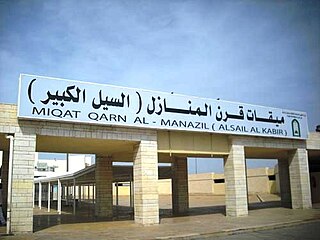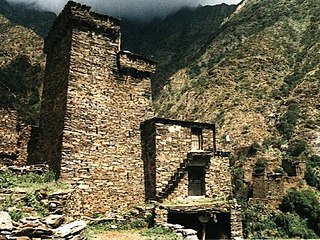
Mecca, officially Makkah al-Mukarramah and commonly shortened to Makkah, is a city and administrative center of the Mecca Province of Saudi Arabia, and the holiest city in Islam. The city is 70 km (43 mi) inland from Jeddah on the Red Sea, in a narrow valley 277 m (909 ft) above sea level. Its last recorded population was 1,578,722 in 2015. The estimated metro population in 2020 is 2.042 million, making it the third-most populated city in Saudi Arabia after Riyadh and Jeddah. Pilgrims more than triple this number every year during the Ḥajj pilgrimage, observed in the twelfth Hijri month of Dhūl-Ḥijjah.

The Stoning of the Devil is part of the annual Islamic Hajj pilgrimage to the holy city of Mecca in Saudi Arabia. During the ritual, Muslim pilgrims throw pebbles at three walls, called jamarāt, in the city of Mina just east of Mecca. It is one of a series of ritual acts that must be performed in the Hajj. It is a symbolic reenactment of Ibrahim's hajj, where he stoned three pillars representing the temptation to disobey God.

Mount Arafat, and by its other Arabic name, Jabal ar-Raḥmah, is a granodiorite hill about 20 km (12 mi) southeast of Mecca, in the province of the same name in Saudi Arabia. The mountain is approximately 70 m (230 ft) in height, with its highest point sitting at an elevation of 454 metres.

There have been numerous incidents during the Hajj, the Muslim pilgrimage to the city of Mecca, that have caused loss of life. Every follower of Islam is required to visit Mecca during the Hajj at least once in his or her lifetime, if able to do so; according to Islam, the pilgrimage is one of the Five Pillars of Islam. During the month of the Hajj, Mecca must cope with as many as three million pilgrims.
The 2006 Hajj stampedeor crush resulted in the deaths of 363 pilgrims on 12 January 2006 during the Hajj in Mecca. It took place on Jamaraat Bridge around 1pm on 12 January 2006, the fifth and final day of the Hajj. Between two and three million pilgrims attended the Hajj in 2006. Earlier, on 5 January at least 76 pilgrims died when a hostel collapsed in Mecca.

Mina, also transliterated as Muna, and commonly known as the "City of Tents" is a valley and neighborhood located in the Masha'er district in the Makkah Province of Saudi Arabia, 8 kilometres southeast of the city of Mecca, covering an area of approximately 20 km2 (7.7 sq mi). Mina incorporates the tents, the Jamarat area, and the slaughterhouses just outside the tent city.

Muzdalifah is an open and level area near Mecca in the Hejazi region of Saudi Arabia that is associated with the Ḥajj ("Pilgrimage"). It lies just southeast of Mina, on the route between Mina and Arafat.

The miqat is the principal boundary at which Muslim pilgrims intending to perform the Ḥajj or Umrah pilgrimages must be enter the state of iḥrām, a state of consecration in which certain permitted activities are made prohibited.

The Farewell Pilgrimage refers to the one Hajj pilgrimage that Muhammad performed in the Islamic year 10 AH, following the Conquest of Mecca. Muslims believe that verse 22:27 of the Quran brought about the intent to perform Hajj in Muhammad that year. When Muhammad announced this intent, approximately 100,000 of his Sahaba gathered in Medina to perform the annual pilgrimage with him. Muhammad performed Hajj al-Qiran.

The four holiest sites in Islam are the Kaaba inside the Masjid al-Haram in Mecca as the holiest of the four, followed by Al-Masjid an-Nabawi in Medina, Al-Aqsa Mosque in Jerusalem and the Umayyad Mosque in Damascus; these sites are accepted in this order by the overwhelming majority of Islamic sects which are all held in high esteem. The two holiest sites of Mecca and Medina in Saudi Arabia are directly mentioned or referred to in the Quran.

The Day of Arafah is an Islamic holiday that falls on the 9th day of Dhu al-Hijjah of the lunar Islamic Calendar. It is the holiest day in the Islamic calendar, the second day of the Hajj pilgrimage, and the day after is the first day of the major Islamic holiday of Eid al-Adha. At dawn of this day, Muslim pilgrims will make their way from Mina to a nearby hillside and plain called Mount Arafat and the Plain of Arafat. It was from this site that the prophet Muhammad gave one of his last sermons in the final year of his life. Some Muslims hold that part of the Quranic verse announcing that the religion of Islam had been perfected was revealed on this day.

Saudi Arabia is the second biggest tourist destination in the Middle East with over 16 million visiting in 2017. Although most tourism in Saudi Arabia still largely involves religious pilgrimages, there is growth in the leisure tourism sector. As the tourism sector has been largely boosted lately, the sector is expected to be the white oil for Saudi Arabia. This is proved as tourism sector is expected to generate $25 billion in 2019. Potential tourist areas include the Hijaz and Sarawat Mountains, Red Sea diving and a number of ancient ruins.

The Hajj is an annual Islamic pilgrimage to Mecca, Saudi Arabia, the holiest city for Muslims. Hajj is a mandatory religious duty for Muslims that must be carried out at least once in their lifetime by all adult Muslims who are physically and financially capable of undertaking the journey, and of supporting their family during their absence from home.

The 2009 Saudi Arabian floods affected Jeddah, on the Red Sea (western) coast of Saudi Arabia, and other areas of Makkah Province. They have been described by civil defence officials as the worst in 27 years. As of 3 January 2010, some 122 people had been reported to have been killed, and more than 350 were missing. Some roads were under a meter of water on 26 November, and many of the victims were believed to have drowned in their cars. At least 3,000 vehicles were swept away or damaged. The death toll was expected to rise as flood waters receded, allowing rescuers to reach stranded vehicles.

The Mecca Metro or Makkah Metro is a metro system with four planned lines in the city of Mecca, Saudi Arabia. The Metro was constructed by China Railway Construction Corporation and is run by Mecca Mass Rail Transit Company (MMRTC). The metro forms part of the 62-billion-riyal Mecca Public Transport Programe (MPTP), which will include integrated bus services.

Lists of mosques cover mosques, places of worship for Muslims. The lists include the most famous, largest and oldest mosques, and mosques mentioned in the Quran, as well as lists of mosques in each region and country of the world. The major regions, Africa, Americas, Asia, Europe and Oceania are sorted alphabetically. The sub-regions, such as Northeast and Northwest Africa in Africa, and Arabia and South Asia in Asia, are sorted by the dates in which their first mosques were reportedly established, more or less, barring those that are mentioned by name in the Quran.

The Al Mashaaer Al Mugaddassah Metro line, is a metro line in the city of Mecca, Saudi Arabia. Claimed to have the highest capacity of any metro in the world, it operates for 7 days a year, and is used as an exclusive shuttle train for pilgrims between holy sites in Mecca, Mount Arafat, Muzdalifah and Mina to reduce congestion caused by thousands of buses and cars during the Hajj. It is the second metro system on the Arabian Peninsula, after the Dubai Metro.

The Khalili Collection of the Hajj and the Arts of Pilgrimage is a private collection of around 4,500 items relating to the Hajj, the pilgrimage to the holy city of Mecca which is a religious duty in Islam. It is one of eight collections assembled, conserved, published and exhibited by the British-Iranian scholar, collector and philanthropist Nasser Khalili; each collection is considered among the most important in its field. The collection's 300 textiles include embroidered curtains from the Kaaba, the Station of Abraham, the Mosque of the Prophet Muhammad and other holy sites, as well as textiles that would have formed part of pilgrimage caravans from Egypt or Syria. It also has illuminated manuscripts depicting the practice and folklore of the Hajj as well as photographs, art pieces, and commemorative objects relating to the Hajj and the holy sites of Mecca and Medina.

Muhammad Sadiq Bey was an Egyptian army engineer and surveyor who served as treasurer of the Hajj pilgrim caravan. As a photographer and author, he documented the holy sites of Islam at Mecca and Medina, taking the first ever photographs in what is now Saudi Arabia.
















